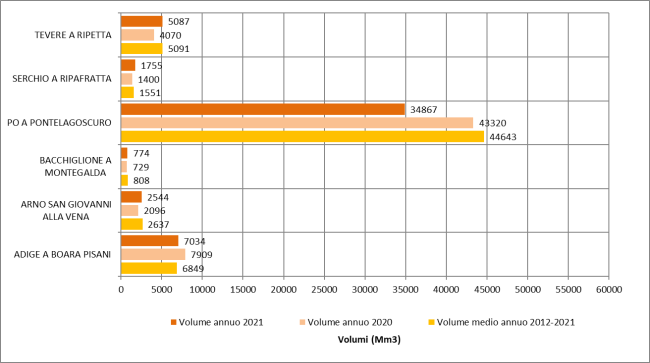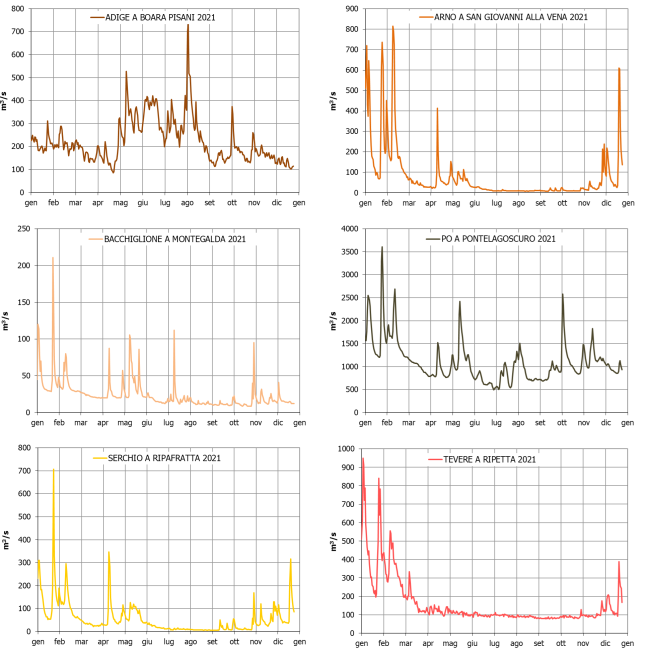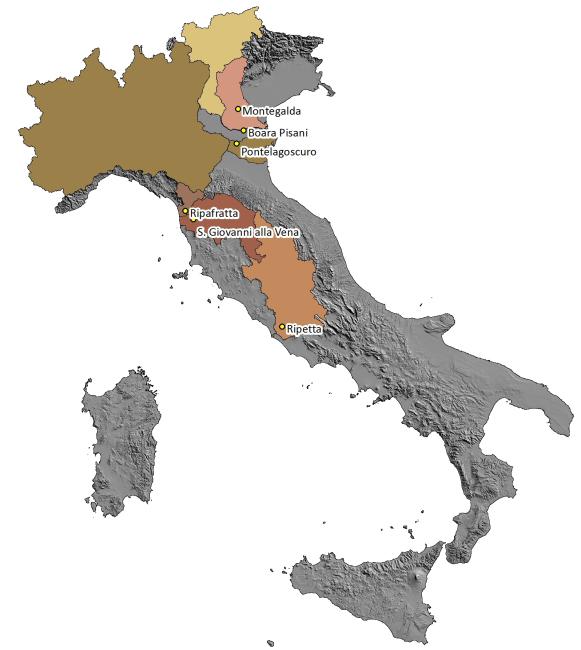Panel 1
Barbara Lastoria
The indicator provides an assessment of the trend of water volumes measured in bedside sections of some of the main Italian watercourses compared to the year and the previous decade. For 2021 it was possible to represent the data of scope for 6 sections of closure of as many waterways of national importance (Po, Arno, Adige, Bacchiglione, Serchio and Tiber). In 2021, the annual volumes drained in the measurement sections showed significant increases compared to 2020, with increases of between 6% and 25%, with the exception of the sections on the Adige and the Po.
It is a state indicator that measures the volume of water (cubic meters) that passes through a given section of a watercourse in the unit of time (second). The flow measurement of watercourses is carried out by the regional structures in the peripheral offices of the National Hydrographic and Tire Service according to standards and procedures published by the SIMN in the notebook "Technical standards for the collection and processing of hydrometeorological data - part II", compliant with the World Meteorological Organization (WMO) standards.
The systematic measurement of watercourse discharges plays a fundamental role as it allows for:
-
assessing the response capacity of a basin to a rainfall event, which is essential for soil protection purposes and to fulfill the obligations set out in Legislative Decree 49/2010, implementing the European Floods Directive 2007/60/EC;
-
determining the amount of resource available during the period, necessary for the evaluation of the hydrological balance;
-
defining qualitative parameters as indicated in Legislative Decree 152/06 and in the Water Framework Directive 2000/60/EC.
Directive 2007/60/EC
Directive 2000/60 / EC
D.Lgs. 49/2010
D.Lgs. 152/2006
D.M. 28/07/2004
D.Lgs. 112/1998
The Italian legislation in force obliges the achievement of specific environmental objectives for waterways also in quantitative terms (eg minimum vital outflow). The indicator contributes to the achievement of the objectives set by Legislative Decree no. 152/06.
Panel 2
WMO (2008) No. 168: Guide to Hydrological Practices Volume I: Hydrology, From Measurement to Hydrological Information
Servizio Idrografico e Mareografico Nazionale, Roma 1997 - Norme tecniche per la raccolta e l’elaborazione dei dati idrometeorologici
Servizio Idrografico e Mareografico Nazionale - Pubblicazione n. 17, Roma 1970
Servizio Idrografico e Mareografico Nazionale - Annali Idrologici
Barbara Lastoria (2008): "Hydrological processes on the land surface: A survey of modelling approaches".
FORALPS Technical Report, 9. Università degli Studi di Trento, Dipartimento di Ingegneria Civile e Ambientale, Trento, Italy, 56 pp. ISBN 978-88-8443-228-5.
Giovanni Braca (2008): "Stage-discharge relationships in open channels : Practices and problems". Foralps technical reports, 11. Università degli Studi di Trento, Dipartimento di Ingegneria Civile e Ambientale, Trento, Italy, 28 pp.;24 cm. ISBN 978-88-8443-230-8
ISPRA, Annuario dati ambientali – Edizione 2021
The extent measurement in a section of a watercourse is a very expensive activity, as it requires highly specialized personnel and the contextual topographic survey of the section. For this reason, when it is considered that the section (and therefore the related outflow scale) has not undergone significant changes, it is preferable to estimate the flow rates through the measurements of hydrometric heights, converting the latter into the corresponding flow values.
Maintenance of the sections of measurement and updating of outflow scales also through a systematic campaign of flow measurements and topographic surveys of the sections.
Data quality assessment
ARPA/APPA
The data of scope are included among the hydrological data and are therefore published by the regional and provincial structures to which, according to Article 92 of Legislative Decree no. 112 of 31 March 1998, functions and tasks of the peripheral offices of the National Hydrographic and Tiring Service (SIMN) of the Department for National Technical Services, now merged into ISPRA, have been transferred. The average daily flow data used in the processing of the indicator are partly easily accessible via the web by consulting: ARPA Emilia Romagna: https://www.arpae.it/envodities/meteo/meteo/report-meteo/annali-hydrological; ARPA Veneto: https://www.arpa.vene.it/arpavinforma/bollettini; Centro Functional Regione Toscana http://www.idropisa.it/consistenza-rete.
6 national relief basins out of 11
2012-2021
Indicator assessment
The average daily range is the basic data. On it are conducted preparatory operations for the verification of the completeness of the series. The calculation of the volumes of annum drained in the year analyzed is carried out by integrating the average monthly flow rates on the annual duration, in turn calculated as an average of the average daily flow rates. Similarly, the volumes refer to the previous decade are carried out, compared to which the integrated flow rates are calculated as monthly averages over the previous 10 years. With regard to the analysis of monthly flows, the ratio between the average monthly courses of the year is analysed and the average monthly average rates calculated over the previous 10 years.
Contrary to what was observed for 2020, in 2021, four of the six basins considered the volumes of money flowed into the measurement sections, they have significant increases compared to 2020, with increases between 6% and 25%. The exceptions are the Adige and the Po for which the volumes of a year outflow through the sections of Boara Pisani and Pontelagoscuro have reductions compared to 2020 of about 11% and 20% (Figure 1). The decrease in volumes in 2021 for the Pontelagoscuro section on the Po is even more significant considering that the volumes of 2020 are 22% lower than the average value calculated on the previous decade. The case of the Adige is different, which, while marking a decline in annual volumes compared to 2020, presents in the section of Boara Pisani a modest increase of about 3% compared to the previous decade. For all the sections considered in January and February 2021, the average monthly flow rates were higher than the average values for the previous decade, as can be seen from the trend of the ratios between the average monthly courses (Figure 2). For the sections of Boara Pisani on the Adige and Ripafratta on the Serchio, this condition occurred respectively for 7 and 6 months. Values of more than double flow were recorded in January for the sections of San Giovanni alla Vena, Ripafratta sul Serchio and Ripetta sul Tever. This surplus of flow rates partly offset the fact that in the Riparacted section on the Serchio for 3 months the flow rates were more than 20% lower than those of the previous decade with a negative peak of almost 60% less in March. Similarly in the section of San Giovanni alla Vena sul'Arno the surplus of flow rates in the first months of the year made less significant the reduction in annual volumes (-4%) although for 6 months the flow rates were more than 20% lower than the values of the previous decade and this reduction was for 3 months even more than 70%. In the Ripetta sul Tevere section, with the exception of the month of November in which the courses almost halved compared to those of the previous decade, the average monthly courses of 2021 have never decreased by more than 30% compared to the average courses of the decade. In 2021 the least favorable months with reference to the measurement sections considered were those of October and November in which the flow rates of all the sections were all kept below the average values referring to the decade.
It is not possible to express a judgment on the trend of this indicator as it would be necessary to trace the natural conditions, i.e. not influenced by the anthropic action (pre-lemen, derivations, works of flood). Moreover, although it is possible to easily make comparisons with the previous decade, it is complex to analyze the reasons to be attributed to sensitive deviations due to the different interactions that pressures can exert between them.
Data
Figure 1: Comparison between volumes of annual flow from 2021 and those flowed respectively in the year and in the previous decade for the Adige sections in Boara Pisani, Arno a San Giovanni alla Vena, Bacchiglione in Montegalda, Po in Pontelagoscuro, Serchio a Ripafratta and Tevere in Ripetta
ARPA/APPA, Regional Functional Centres of Civil Protection
Figure 2: The ratio between the average monthly reach of the year 2021 and the average monthly flow rate calculated on the previous decade for the Adige sections in Boara Pisani, Arno in San Giovanni alla Vena, Bacchiglione in Montegalda, Po in Pontelagoscuro, Serchio a Ripafratta and Tiber in Ripetta
ARPA/APPA, Regional Functional Centres of Civil Protection
Figure 3: Average daily ranges recorded during 2021, in the Adige sections in Boara Pisani, Arno in San Giovanni alla Vena, Bacchiglione in Montegalda, Po a Pontelagoscuro, Serchio a Ripafratta and Tiber in Ripetta
ARPA/APPA, Regional Functional Centres of Civil Protection
Figure 4: Localization of flow measurement sections (Adige a Boara Pisani, Arno a San Giovanni alla Vena, Bacchiglione a Montegalda, Po a Pontelagoscuro, Serchio a Ripafratta e Tevere a Ripetta) with respect to the relevant river basins
ISPRA processing on data provided by ARPA/APPA, Regional Functional Civil Protection Centres





For 4 of the 6 measuring sections considered (whose spatial placement and their characteristics are reported respectively in Figure 4 and in Figure 5), the annual volumes recorded in 2021 are higher than those of the previous year, with percentages that for 3 of the 4 sections exceed 20%, while the gap is smaller than the average values calculated on the decade of comparison except for the Pontelagoscuro section on the Po (Figure 1). For this section, in fact, the decrease in volumes compared to both 2020 and the deed of comparison is about 20%. These evaluations are found from the observation of the graph shown in Figure 2 in which the normalized value of the monthly average amount is represented, obtained from the ratio between the average monthly flows recorded in 2021 and those obtained by mediating the values of the previous decade, for which a continuous series of data is available. The most critical months were those from September to November, the latter month in which all sections recorded reductions of more than 35% of the average monthly rates compared to the decent. This is in line with what is described in the indicator "hydrological shock" published in the Bank data indicators ISPRA 2022, in relation to the fact that at the end of 2021 different localized drought situations have affected Northern Italy as precursors of severe or extreme drought situations that have occurred, persistently, in 2022. In the period September-November 2021, in particular, at the section of San Giovanni alla Vena on the Arno the monthly flow values were not only systematically below the average values referring to the previous decade, but in 2 of the 3 months were less than half. Conditions of deficit of marked scope also occurred in March and concerned the sections of San Giovanni alla Vena sull'Arno and Ripafratta sul Serchio, while in terms of persistence of the conditions of scale deficit, in addition to the section on the Arno, are the sections of Ripetta sul Tevere and Pontelagoscuro on Po with those in which for at least 6 months the monthly flow rates of 2021 were less than 80% of the tense. For the Ripetta section the reduction compared to the previous decade is observed for 10 consecutive months, with the exceptions of the months of January and February, in which all the sections recorded monthly loads above the averages of the decade. In the last 3 months of the year, the section of Montegalda on the Bacchiglione is characterized by monthly flow rates permanently below 70% of the flow rates of the decade. The only section in which in 2021 there is an increase in volumes compared to the previous year and compared to the decade of comparison is that of Ripafratta on the Serchio for which the increase is 25% compared to 2020 and 13% compared to the decade. In most of the flow sizes sections considered, the most significant floods occurred in January and February, with the exception of the Boara Pisani section on the Adige that is more affected by the effect of the Nivale dissolution in the summer period (Figure 3).